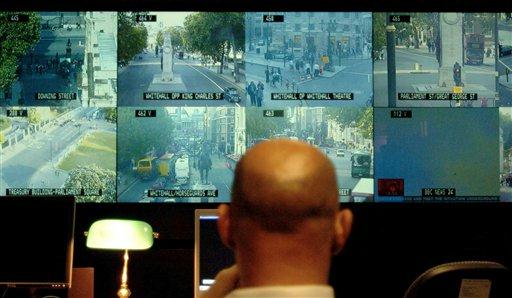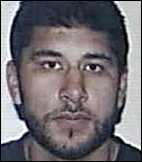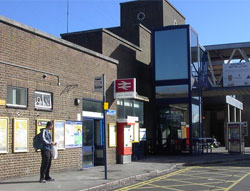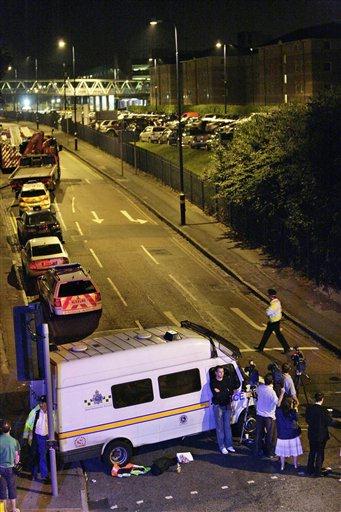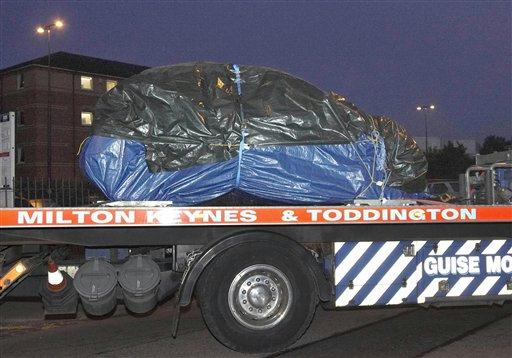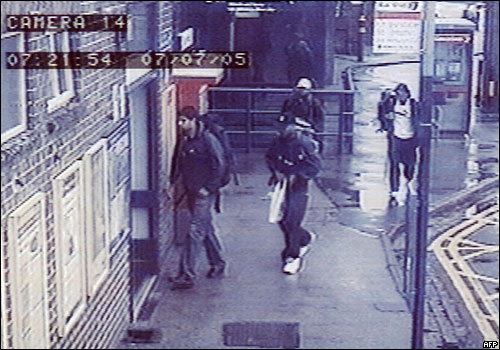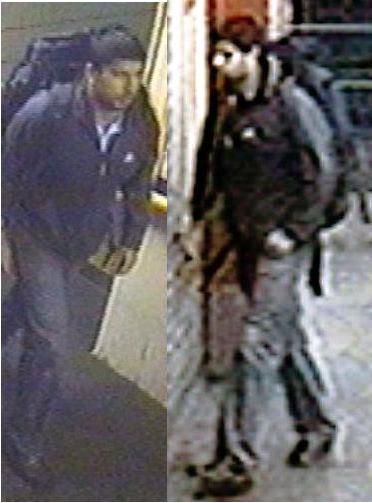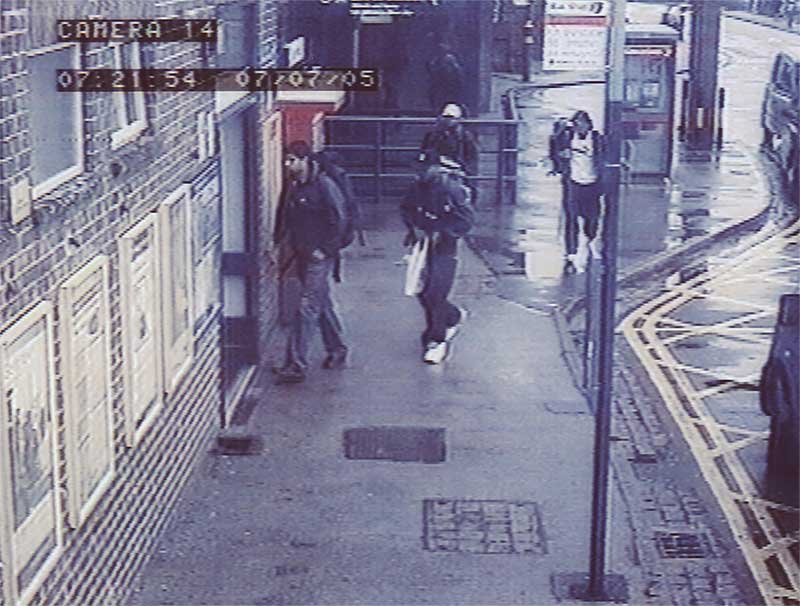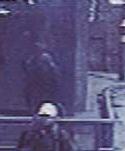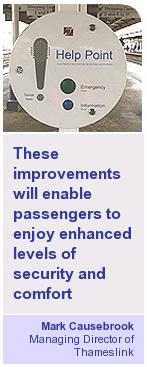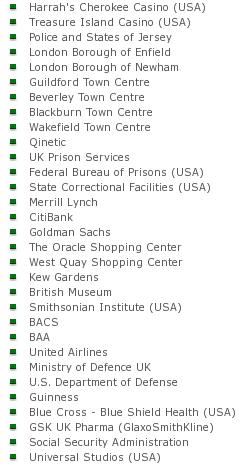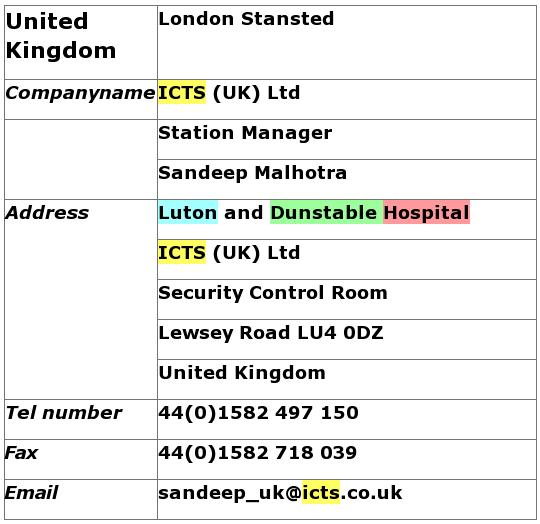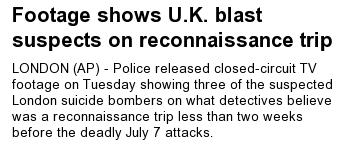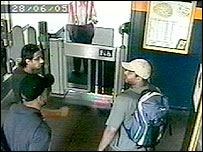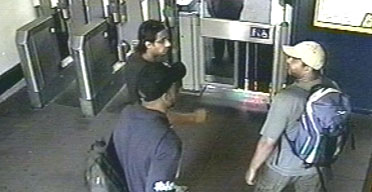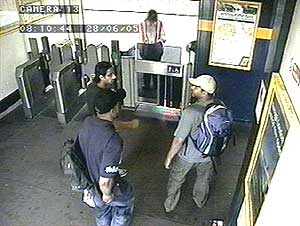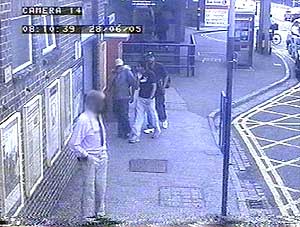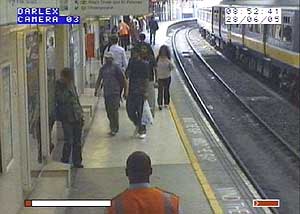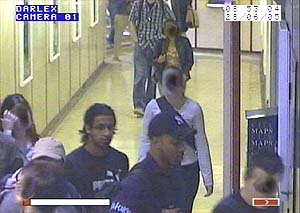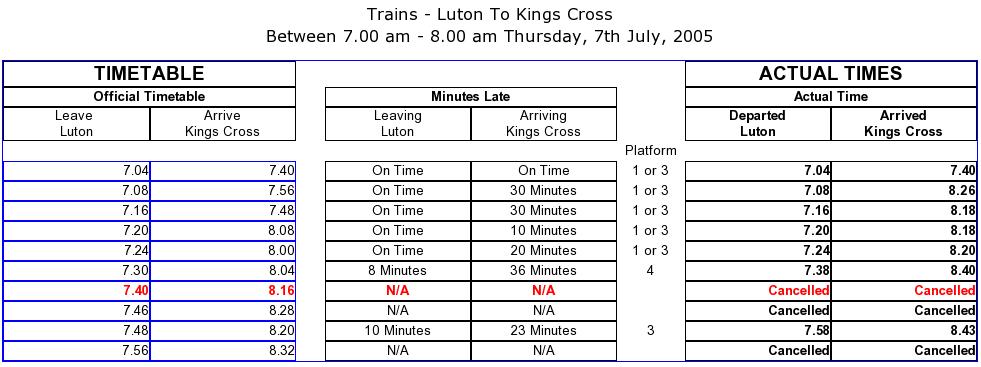|
Police look to closed-circuit TV
Surveillance cameras may yield clues to London bombings
LONDON, England (AP) -- Almost everywhere Londoners go in public, chances are they're being tracked by cameras.
Now officials say the British capital's ubiquitous closed-circuit TV cameras may hold the key to helping police determine who was behind Thursday's attacks. Thousands of them watch the subway system alone, and investigators have used the footage in the past to solve crimes.
London's train stations are monitored by 1,800 cameras, and there are more than 6,000 watching the capital's Underground subway network. Cameras also have been installed on some London buses. On top of that, more and more people carry pocket-size digital cameras and camera phones, and some footage from such sources, inside subway cars, had already found its way to British TV by afternoon.
"Clearly we've had considerable success in the past using closed-circuit television footage in order to trace the movements of the people involved" in various crimes, Deputy Assistant Commissioner Brian Paddick said after Thursday's bloody subway and bus attacks.
"That will be one of our first priorities, as well as securing whatever forensic evidence we can secure from the various scenes," Paddick said.
Police will have full access to all footage taken of the London subway system and the bus network, as well as images from cameras mounted around the entrances to stations and at bus stops, authorities said Thursday.
An estimated 4.2 million cameras -- largely concentrated in London and other major cities -- observe Britons as they go about their daily business, whether they're waiting for a bus, riding a train, lining up at a bank or parking a car in a public garage. The phalanx of security cameras has earned Britain a reputation as a world leader of surveillance, and has led to criticism that the constant monitoring takes the Orwellian concept of "Big Brother" to an extreme.
Critics contend the system is of limited use because the monitoring screens at the CCTV command post aren't closely watched in real time, meaning the images rarely are used to stop a crime in progress -- only help authorities investigate one after the fact.
It's widely estimated that the average Briton is caught on various cameras up to 300 times on a normal day.
But police have had success in the past in solving crimes by poring over frames of video footage. Such work has become a routine part of police operations, the Metropolitan Police said. Last year, closed-circuit video helped British authorities in several high-profile cases, including a 12-year-old boy who robbed a store at gunpoint; the disappearance of a doctor; attacks by a serial rapist; a father and son hit by a train; a rash of school laptop computer thefts; and a soccer riot.
- CNN
|
NO CCTV operating on Tavistock Bus
|
EXCLUSIVE: THE HUNT
9 July 2005 - SCOTLAND Yard launched Britain's biggest ever manhunt yesterday to catch the London bombers - vowing: "We will go to the ends of the earth to nail these coldblooded killers."
[snip]
But the investigation received a serious setback when it was discovered the CCTV cameras on the bus that blew up were not working so detectives will not get vital images of the bomber. One senior Yard source said: "It's a big blow and a disappointment. If the cameras had been running we would have had pin-sharp close-up pictures of the person who carried out this atrocity.
"We don't know if the driver forgot to switch them on or if there was a technical problem but there are no images."
The bus had four cameras - one covering people getting on, the second at the exit doors and one on each deck scanning the length of the vehicle. - mirror
|
|
"CCTV gets maintained at least 2 or 3 times a week and can digitally store upto 2 whole weeks worth of footage. this is done by a private contractor....So when I heard that the CCTV wasn't working on a vehicle that's no more than 2 years old since last June.....I'm sorry that's rubbish, I work for the company I know different."
Also a point of interest....last saturday a contractor came to inspect the CCTV on the buses at the depot, According to my supervisor the person spent more than 20 hours over that weekend, 20 hours to see if the CCTV is working? Also that person who came was not a regular contractor, for security reasons the same few people always come to the depot to carry out work, this time it was different.
Drivers in the depot already think the so called bombers had inside help because it was to organised. Some even think it had help from the company."
I have received other information suggesting that the CCTV is regularly maintained and checked. The police pay the bus company to check it, and the bus company makes a substantial profit out of this, so all parties benefit from keeping the CCTV systems working.
This information makes it all the more suspicious that the bus cameras were not working.
- Alex Jones & Paul Joseph Watson
|
|
|
Face of London bus bomber
14/07/2005 - 17:58:04 - Detectives today issued a picture of one of the London suicide bombers as they appealed for public help in tracing his last moments.
Hasib Hussain, 18, blew himself up on the number 30 bus in Tavistock Square along with 12 other people. The head of Scotland Yard anti-terrorist branch, Peter Clarke, said police wanted to know what Hussain was doing in the hour after his three fellow bombers blew themselves up on tube trains. They detonated their devices at 8.50am but Hussain did not trigger his bomb until 9.47am. - IOL
|
|
The entrance from the Car Park
overlooking the Car Park....
overlooking the Car Park....
|
Car could hold clues to London bombings
A CAR which could hold vital clues to the London bombings stood undiscovered in a Leighton compound for five days.
It was revealed late on Tuesday night how the vehicle had been routinely recovered from Luton railway station hours AFTER four bombers struck tube trains and a bus in the capital last Thursday. Police and intelligence services investigating the outrages swooped on a car still parked at Luton station on Tuesday morning and linked it to the suicide bombers.
That was then linked to a second car which had been towed to J & K Recovery Ltd in Grovebury Road, Leighton.
By Tuesday evening Beds Police, working alongside the Metropolitan Police and British Transport Police, sealed off a 100 metre cordon around the depot and began a painstaking search for evidence and explosives - as had been found in the Luton car.
A number of workers had been sent home earlier in the day from businesses on the industrial estate, although no homes were evacuated.
Grovebury Road was reopened at 9.30pm, although a police presence remained in place at the entrance to the depot until the early hours.
It is believed the car has now been removed from the compound.
Ch Supt Mike Colbourne, of Leighton Buzzard Police, told the Citizen they had no prior warning but the safety of the public was their primary concern.
He said: "We have done everything we can to deal speedily and effectively with property from the vehicles to ensure the public's safety.
"We are very thankful to the public in assisting the police and are sorry for any inconvenience this has caused.
"We are continuing to work with the Metropolitan Police to ensure the investigation continues in a safe and thorough manner.
"A number of police officers and specials offered to assist with duties and I am very grateful to them for their help."
Last night police would not reveal why the car was towed away or what was inside.
The four men, who police believe died carrying out the bombings, travelled on the 7.48am commuter Thameslink train from Luton to Kings Cross last Thursday. - leightonbuzzardonline.co.uk
|
London bomb suspects ID'd
By DON MELVIN
The Atlanta Journal-Constitution
Published on: 07/13/05
LONDON - British police said Tuesday they suspect that four men detonated bombs on the London transport system and died in the explosions, suggesting that last week's attacks were the work of suicide bombers. One of the bombers is thought to have been as young as 19. At least three are believed to be British men of Pakistani origin who lived in the Leeds area of West Yorkshire, home to a large Muslim population.
British police conducted a fingertip search of London's Tavistock Square on Tuesday for evidence in Thursday's bus bombing. Investigators identified three of the men from documents found at the crime scenes and video from surveillance cameras. Police on Tuesday searched six houses in Leeds - three of which the men had lived in - blasting their way into one unoccupied house using a robot.
The BBC quoted an unnamed police official as saying that a "significant amount" of explosive material was found. Police arrested a relative of one of the suspects and brought him to London for questioning. They released no names.
Britons were riveted to TV reports throughout the day as police found explosives in a car parked at a train station in Luton, 30 miles north of London, and carried out five controlled explosions in the area.
A second car believed to be linked to the attacks was found at Leighton Buzzard, 10 miles west of Luton.
An alert was issued for the House of Commons in London and security was tightened there, but no evacuation order was issued, officials said. They offered no explanation for the alert. Police have not identified the fourth bomber and do not know if his remains are at the King's Cross blast site or if he survived and has fled. If the attacks were the work of suicide bombers, it is a development that poses an even greater threat than was previously thought, one expert said, as it would mark the first time suicide bombers had carried out attacks in Western Europe. The explosions killed at least 52 people and injured more than 700. British officials have said the attacks bear the hallmarks of the al-Qaida movement, responsible for the Sept. 11, 2001, attacks in the United States.
"This is a new level of radicalization for the U.K.," Alex Standish, editor of Jane's Intelligence Digest, told the Reuters news agency. "Suicide bombings are commonly accepted to be the most dangerous and difficult to thwart."
Using a combination of evidence recovered from the scenes and closed-circuit television, police were able to identify three suspects and retrace their movements.
One of the suspects had been reported missing by his family Thursday evening after the terrorist attacks. Police said some of his belongings were found in the wreckage of the double-decker bus in which 13 people died.
"We have now been able to establish that he was joined on his journey to London by three other men," said Peter Clarke, the head of the terrorist branch of the Metropolitan Police.
All four men were taped on closed-circuit cameras arriving at the King's Cross subway station just before 8:30 a.m., police said. The men, who had boarded a train in Luton, were carrying backpacks.
[webmasters note: where is this evidence?]
Bombs exploded on three subway trains - each of which had passed through the King's Cross station at 8:50. Police do not yet know why the fourth attack, on the bus, did not take place until almost an hour later. Some witnesses reportedly have said the bus bomber fumbled with his device. British news media have quoted an eyewitness who got off the bus just before it exploded as saying he saw an anxious man in his 20s struggling with something in his bag.
"Everybody is standing face to face and this guy kept dipping into this bag," Richard Jones, 61, of Berkshire, told the BBC.
Police said it was "very likely" that the body of one bomber was found in the subway wreckage between Liverpool Street and Aldgate. Property from two other suspects was found at each of the other subway bombing sites.
Leeds, a city of 715,000 people 190 miles north of London, has a thriving Muslim community of about 30,000. In all of Britain, about 1.8 million people - 3 percent of the population - are Muslim, half of them born in England. Muslims are by far the country's largest nonChristian religious group. Police did not identify the suspects by religion or ethnic origin.
But Sir Iqbal Sacranie of the Muslim Council of Britain said he had received the news from the police with "anguish, shock and horror."
"It appears our youth have been involved in last week's horrific bombings against innocent people," he said. "While the police investigation continues, we reiterate our absolute commitment and resolve to helping the police bring to justice all involved in this crime of mass murder. Nothing in Islam can ever justify the evil actions of the bombers."
Attacks on mosques have been reported in the days since the terrorist bombings. Police sought Tuesday to stem the backlash. "No one should smear or stigmatize any community with these acts," said Assistant Police Commissioner Andy Hayman. The U.S. Air Force, following a groundswell of outrage, rescinded an order banning personnel at two air bases in London from visiting the city - an order that flew in the face of a determined effort by British officials to return the city to normal life.
- The BBC, Associated Press and Reuters contributed to this article
|
|
This car was one of 2 impounded...it was taken 10 miles to Leighton Buzzard...why?
Luton has a big Police Station...resources...
were 9 bombs er no 12 bombs [or even 16] really found in the boot of one of the cars..?.
er what are these terrorists going to do...???,
come back from the dead, using their return tickets, I presume, and use these bombs?...Did they leave them for a second wave? Or was this story of 'bombs in the cars' a preparation for the next phase of the story?
|
|
Bomb disposal experts found another nine bombs in Lindsay's red Fiat, which had been left in the car park at Luton railway station. The CCTV image released by Scotland Yard yesterday showed the four bombers carrying rucksacks as they entered Luton station at 7.21am on Thursday, July 7. Intelligence has connected Lindsay to a "bomb factory" in Beeston, Leeds, where the terror cell and its "chemist" are believed to have stored materials to make bombs.
- timesonline.co.uk
red Nissan or red Fiat Punto????????
|
Hassib Hussain
WHEN? where is the timecode?
|
Police release photos of bomb suspect
July 15, 2005. 8:03am British police have released two photographs of a man thought to have carried out one of four suicide attacks in London, launching a public appeal for help in tracing the suspect's last moments.
Police released pictures of Hassib Hussain, an 18-year-old from West Yorkshire in northern England, who they believe was responsible for the attack on a bus in Tavistock Square that killed 13 people, including himself.
Peter Clarke, head of Scotland Yard's anti-terrorist branch, also said police had identified a second bomber, who died in the blasts, and had evidence that two further, unidentified, suspects also died in the explosions.
He appealed for any information about Hussain, shown in one of the pictures carrying a large rucksack, in an effort to piece together his movements between leaving Kings Cross and boarding the Number 30 bus. - Police release photos of bomb suspect
|
Luton CCTV photo released
|
CCTV image shows bombers' meeting
17 jul05 - BRITISH police today released a security camera image showing the four suspected London suicide bombers together at Luton station after confirming their identities. The picture shows the four men, all toting large rucksacks and at least two wearing baseball caps, on the morning of the attacks.
Scotland Yard said the footage was taken at Luton station, 40km north of London, where the four men met about 7.20am (4.20pm AEST) on July 7, before heading to London's King's Cross station. There they were also filmed together shortly before 8.30am.
The picture was released as police today confirmed the identity of the last two London suicide bomb suspects as Mohammed Sidique Khan and Germaine Lindsay. "We can now confirm the identity of a third man who travelled from West Yorkshire and who died in the explosion at Edgware Road. He was Mohammed Sidique Khan, aged 30," Scotland Yard said.
"We believe that he was responsible for carrying out that attack. "We can also now confirm the identity of a fourth man who arrived in London with the three men from West Yorkshire (in northern England) and then died in the explosion between King's Cross and Russell Square underground stations. "He was Germaine Lindsay. aged 19. We believe that he was responsible for carrying out that attack."
The CCTV image shows from left to right Hasib Hussain, Germaine Lindsay, dark cap, Mohammed Sidique Khan, light cap, and Shahzad Tanweer.
CCTV image shows bombers' meeting
|
|
|
are we really to believe that there
are only 2 photos of the 777 bombers?
Photo shenanigans
Left: 2 shots of Hasib Hussein at Luton - Same Guy?
|
|
spot the difference
|
Press released photo is darker...has heightened contrast
some of the foreground & the entire right portion of the photo has been cropped out
By use of editing. Were the press trying to suggest that these people were sneaking into the station?
are they trying to evoke a sinister atmosphere by darkening the image & adjusting the contrast?
who made these editing decisions, and WHY?
|
The MET Police website edited out everything but the bombers on a page that links to the uncropped photo

so we seem to have a little more information
|
a reflection?
of the white capped
'bomber'?
or a window to other people?
|
|
notice
right at the top
a man walking?
|
>>>>
a van with
its doors open
and someone
unloading?
or a taxi cab?
|
|
>>>>
a Bus or
a Transit van?Driver inside?
|
|
|
a figure
in front
about to
take a step
or the front
wheel arch
of a black
Hackney Cab?
|
a boy?

|
|
I count 5 potential witnesses
|
Man walking [extreme top right of MET photo]
Person/s in window behind 'white cap'
legs visible of person unloading 'white van'/taxi cab
Person in front [boy?]
Potential Bus/Transit driver
|
|
was 'the boy' with the 'bombers'?
|
A CCTV camera filmed them as they prepared to board the 7.40am train to King's Cross. Near them was another man who might or might not have been an accomplice or even a potential fifth bomber - but he disappeared into the crowd.
At 8.26am the train pulled into King's Cross and the four were again caught on CCTV. With their rucksacks they looked, said a source who has seen the film, like hitchhikers "as if they were going on holiday". Betraying no sign of nerves, they parted. One east, one west, one south and, probably, one intending to go north. They were about to detonate a "burning cross" over the heart of London.
The timing may have been significant: 8.50am. In the Koran, chapter 8, verse 50, reads: "And had you seen when the angels will cause to die those who disbelieve, smiting their faces and their backs and saying, 'Taste the punishment of burning'." - London bombs - Times Online
|
|
Flashback:
CCTV and the Mandrake system...
"Mandrake is a neural network based product which provides an ability to recognise faces by comparing templates. The system can take into account variations of head orientation, lighting conditions, skin colour, spectacles, make-up and earrings, facial expressions, facial hair and ageing. In a secure access environment, for example, no special skills are needed to compare faces if a face recognition system fails, unlike all other specialist scanning systems. Facial recognition is also the only biometric technique which can be applied covertly. A 'gallery' if images can then be displayed of the 'top ten' by confidence factor. Mandrake has many applications for Law and Order, Access Control, CCTV Monitoring and other security systems".
Apparently, the system indicates a percentage score of how convinced the computer is that the person spotted is the same when compared to the one in the database. The companies man, Bob Turner of Software & Systems International Ltd, said: "You can set it to alert you at different percentage levels depending on outside conditions. For an outdoor camera, 70-75 per cent will trigger threshold".
He didn't say anything about it accuracy when raining!
Patricia Oldcorn of SSI said:
"It is important to remember that the system is only as good as the cameras used to pick out the suspects. In that sense, the system works like the human eye and the human brain. If a person can't quite see who he is looking at, he will not make a positive identification." (PA News 6 October 98)
The first people to be targeted by Mandrake will be suspected muggers, burglars and shoplifters whose photographs are in police files, but it is believed that the system may also be able to work with e-fit pictures. Liberty is worried about possible breaches of human rights and data protection legislation. This is all off the testbed now. It is alive, well and operating in Newham High Street in East London since October 98. Newham has a network of 140 street cameras as well as 11 mobile camera units. Further, the council is to add yet another 89 camera on the surrounding estates. Images are sent to the council's security centre in East Ham where they are compared with a database of target faces supplied by the police. The system can isolate the targets from the crowd of people appearing on the CCTV screen. When a match is made, the computer highlights the target and sounds an alarm. Attention drawn, the operator then decides if the police should be contacted, or indeed, the image in question being piped through to the local division control room.
The authorities reassure the public yet again, if you've nothing to hide, you've nothing to fear. Only convicted criminal will go onto the system they say. However in the same breath say they think it could be very useful in tracking down missing persons. I think with these capabilities, how are we to be sure that this particular Genie can be kept in its bottle! Their word? With a little imagination, it can be marvelled at the potential for abuse of the system. How about the tracking of 'undesirables' of different sorts, crimes and convictions aside. Big Brother just wanting to know. It is only in the last couple of years that information obtained from a 'videograb', taken of moving faces from a CCTV camera is of practical use for matching. Colour and definition achieved by equipment had improved considerably.
However, operating such new technologies, the company agrees that the computer will not always strike a perfect match. A company spokesman said: "We do expect that we will get a little bit of difference in interpretation because sometimes it will pick up a face at three-quarters angle. We will need to use the human element to check the authenticity of the picture"
Now it is this risk of error that should bother us all. Being lifted off the high street, by a patrol, sent to the scene by some kind of 'identification robot'. Driven to a police station on the other side of the country, only to have another policeman say "That's not him!" on your arrival. God, this sort of thing happens enough as it is! Such risks of error also greatly concerns, Liberty. Their Campaigns Manager Liz Parrett said: "The accuracy of facial mapping is very limited. For example, you only need look at a handful of photos of celebrities to see how different the same people look in different photos. The claim that those who have nothing to hide is rubbish. What the police call an 80% success rate is what we would call a one in five chance of a mistake". She added: "Of course a balance need to be struck between the need of law enforcement and individuals privacy - our view is that this strikes the wrong balance." (Guardian 15th October 98)
Another 'Mandrake type' System has been established to deal with hooliganism at Watford FC soccer ground and is being piloted by Hertfordshire Police. Introduced by the same company, Software & Systems International Ltd, the Face Recognition System uses further advances in the technology to rapidly identify known troublemakers in the crowd. Its built-in camera is designed to allow police in the control room to focus on, and capture, a 'live' image of a suspect. The system then scans a database of stored images of known troublemakers to find a match - at a rate of upwards of 250 images per second.
[Did Lutons' Train station, with its close proximity to the Football club - employ the Mandrake system?]
The blurb says that even if offenders try to disguise their appearance, the system will still identify them, as it is based on recognising facial structure, such as the spacing between the eyes, nose and mouth. It takes into account, and disregards, variations of head orientation, lighting conditions, skin colour, make-up, facial expression, facial hair, spectacles and ageing.
The system is also intended for use in access control for sporting events, the workplace etc. Trials are proceeding apace. In this mode it is designed to authenticate a claimed identity either by entering a PIN or passing a magnetic stripe card through a reader. This causes a specific record to be selected. The image associated with this record can then be compared with the 'live' image in the camera to confirm the identity.
Very surely, a national system, that might be used at airports, stations or public events to 'spot' targets, is developing. The head of research and development at British Telecom, Peter Cochrane, is another who is convinced that: "within four years there will be a system that will allow police the ability to put a name to any face picked up on any closed circuit TV in the country". (Independent 3rd March 97) - All about big brother
|
How Grainy are these CCTV images?
Especially when you consider Thameslink just had a
MAJOR digital overhaul of their CCTV system:

Press release: 10 May 2005 - Thameslink passengers to benefit from £1.2m safety and security improvements
Rail passengers received a boost today with the launch of a £1.2m package of security and safety improvements at Thameslink stations funded by Transport for London (TfL) and Thameslink.
"The measures will provide reassurance to passengers travelling on Thameslink train services and support TfL's aim to improve London's public transport network through its £10bn, 5-year Investment Programme.
The package includes:
Forty-one new CCTV cameras at Elephant & Castle station, giving the station full CCTV coverage for the first time. CCTV aims to prevent real crime and reduce the perception of crime
Installation of enhanced CCTV at six other Thameslink stations
A CCTV monitoring system at Elephant & Castle station (positioned in the ticket office) allowing the duty staff to monitor the station via the 41 new CCTV cameras around the station
Installation of Help Points with induction loops at six stations, providing immediate audio and visual link with the Thameslink CCTV control centres at Tooting, Kings Cross and Luton.
|
|
|
Ian Brown, Managing Director of London Rail, said: "Passenger safety is of paramount importance to TfL.
"Although not part of the TfL network, improving security on rail in London is a top priority as we want to encourage greater public transport use.
We have developed this initiative with Thameslink to provide better security and environmental improvements at stations.
"The work is part of TfL's £10bn, 5-year Investment Programme."
Mark Causebrook, Managing Director of Thameslink, said: "We greatly value the partnership with TfL on this important project.
"These improvements will enable passengers at these stations to enjoy enhanced levels of security and comfort.
"We look forward to working closely with TfL on similar initiatives in the future."
Val Shawcross, London Assembly Member, said: "Too many women feel forced to travel by car in the evening because we don't feel safe on public transport - especially on trains.
'Boost for women'
"With this major upgrading of security on overground stations in Lambeth and Southwark, I hope we can start the upward spiral of more women travelling by train and the network feeling much busier and safer."
|
|
Chief Superintendent Peter Hilton, British Transport Police said: "We are aware that personal security is one of the most important priorities for railway passengers.
"This investment by TfL in better CCTV and an improved station environment is very welcome.
"British Transport Police will be playing their full part in supporting TfL in their efforts to improve passengers' security."
Further improvements include:
Customer Information Systems to give up to date travel information at six stations including Elephant & Castle
New Auto PA tannoy system at Elephant & Castle providing consistent travel, security and safety messages
Improved lighting has been installed at Loughborough Junction and Mill Hill Broadway stations
New anti-vandal shelters will be provided at Hendon and West Hampstead which give hi-visibility shelter for passengers on platforms
Improved signage has been installed at Elephant & Castle and Loughborough stations providing useful information for passengers to find their destination
Platform seating has been installed at five stations, including Elephant & Castle
Environmental improvements such as anti-slip on stairs and footbridges have been made at six stations.
TFL
|
|
ATEC Security Integrates PI Vision's NVR into new Thameslink CCTV System
ATEC Security has completed the design and installation of an upgraded CCTV system at nine railway stations operated by Thameslink. The solution comprises over 80 additional colour cameras, new monitors and communications links. An integral part of the new digital system is the Universal Video Management System (UVMS), PI Vision's third-generation digital CCTV recording system.
|
| some of PI Vision's clients
|
The UVMS was chosen for this project partly because ATEC Security has worked with PI Vision in the past and the NVR has a proven track record.
ATEC Security is a specialist security systems integrator with specific expertise in the design and installation of city and town centre CCTV systems, including control room management systems. It is recognised for its expertise and trusted to provide sophisticated security solutions by a large number of high profile clients throughout the UK including Birmingham City Council, City of London Police, Amey Mouchel and many more.
Six Thameslink stations have been upgraded to digital video storage using RAID level 5 hard disk arrays. All cameras are currently recorded locally, but ATEC Security has designed-in the capability for remote access using 3rd party telecoms infrastructures.
In addition to video recording, the UVMS provides a suite of enhanced video management functions including Evidential Video Master (EVM) for packaging up digital evidence for use by police and internal security, powerful functions for searching archive images, video wall management, wireless PDA connectivity and PTZ camera control.
Simon Adcock, Managing Director of ATEC Security, commented, "The Thameslink project is another high profile demonstration of ATEC Security's system design, communications integration and installation expertise. We have a policy of only using top quality components and had no hesitation in including PI Vision's UVMS in the solution."
David Myers, managing director at PI Vision, commented: "We're pleased to once again be working with ATEC Security on another high profile project. UVMS is ideal for transport applications because of its compatibility with a wide range of standards and technologies and its distributed architecture which allows local recording and central control. It has virtually unlimited upgrade capability, and its many built-in management functions greatly enhance its usability."
Funding for the project was supplied in part by a grant from Transport for London (TfL). The Thameslink project is one of several projects in which ATEC Security has worked with PI Vision. Recently PI Vision supplied an NVR solution to ATEC Security to integrate into the Westminster CCTV system.
intsi.org - pivision
intsi.org [notice the links to FBI & MI5]
|

ICTS in Luton and Dunstable Hospital ?
integrator for ICTS Europe... Fortress GB...London Headquarters in Tavistock Square?
|
In the case of the 7/7 bombings, going straightaway to the video tapes was very premature and irrational. It can only mean that they knew what they would find because they had planted the "evidence". It makes no sense to begin looking at thousands of hours of video tape from as far away as Luton without any idea of what you are looking for. What could it be? Rucksacks, packages, briefcases, baby strollers, gym bags? Suspicous looking people of a certain race? And remember that the first story was that at least 24 people had been involved.
What would be the motivation to look at the tapes from Luton? Did they also look at tapes from video cameras at the airports and bus stations? It would seem to be just as reasonable to look at those tapes as looking at Luton. And why is the Luton tape the only tape?
Luton is interesting because an office of ICTS (the Israeli security firm) is about a mile from a Thameslink station. ICTS is actually located in the Luton and Dunstable NHS Hospital. It seems a little odd that this firm that handles security for the Stansted airport would be located at the Hospital.
[snip]
The real perpetrators give themselves away by going directly to Luton to find their video. What are the chances of that? They went to Luton before there was any forensic investigation at the bomb sites. They were off to Luton even before they had removed all the body parts from the blasts - before they had any evidence that rucksacks were used to bring the bombs onto the trains - they were on their way to Luton to find the pictures of the lads carrying rucksacks and they found them.
- 'impatient' via rense
|

Tavistock!
'impatients' Bomb scenario & 9-11 links
The "Muslim suicide bomber" formula stops inquiry, stops thought, takes precedence in the public imagination over all objections. In the past four years the hundreds of inconsistencies and contrary pieces of evidence about 9/11 have not been able to remove the picture people have in their minds of Muslim hijackers flying planes into the WTC and the Pentagon. The video of these four young men with rucksacks will serve to end the public's interest in the questions of how, who, and why.
But the skeptic might ask some questions here. Why did these "suicide bombers" seem so ordinary, so nonchalant before these awful deeds? Could it be that they were recruited as "extras" in the disaster exercises, and that their only purpose was to be seen in the video, meeting, and carrying their heavy rucksacks? And wouldn't their subsequent disappearance verify that what they carried in their sacks were those explosives that blew the trains, the bus and themselves to kingdom come?
Yesterday I posted information about a security company, Fortress GB, a smart card technology developer and integrator for ICTS Europe. ICTS Europe is an Israeli security company based in the Netherlands, a subsidiary of which is Huntleigh. Huntleigh was the security contractor at Logan Airport on 9/11 that failed to provide us with CCTV evidence of hijackers. The London Underground is one of Fortress GB's clients and according to their press release they provide smart card technology (personal details and biometric information) for contractors that operate in Tube stations. It makes me wonder if Peter Power's Visor Consultants were identified by these smart cards and if the four young men from Leeds were ever issued smart cards." - impatient@libertyforum.org
|
In addition to being Europe's leader in the provision of Aviation Security services, ICTS Europe is also a key provider in the General Security market, with extensive activities performed at its subsidiaries in France, Spain and the UK. ICTS Europe holds numerous long-term contracts in this milieu and provides a wide range of services in such sectors as banking and finance, transport, higher education, health care, museums, theaters and others.
Among the General Security services provided by ICTS Europe:
|
Comprehensive Risk Analysis/Security Reviews/Consulting Services
|
Provision of Site-specific Security Teams
|
Distribution of Security Bulletin/Newsletter
|
Auxiliary Services (Car Park Management, Reception, Drivers etc.)
|
Development of Security Policies and Procedures
|
Custom-designed Training Programs
|
Security Awareness Programs
|
Design and Specification of Technical Security Measures
|
ID and Smart Card Systems Development
|
Security Guard Services
|
Security Alarm Monitoring
|
|
ictseurope.com
|
King cross CCTV footage? Where?
|
Rucksack gang filmed at King's Cross 'looked like the infantry going to war'
By John Steele (Filed: 13/07/2005) - The critical breakthrough in the hunt for the London bombers came on Monday night in a police video viewing suite.
Detectives involved in watching thousands of hours of film for glimpses of the terrorists had been given a "profile" based on a simple question posed for their guidance by senior officers. The question was: what would the terrorists look like? The answer was that they would be young men, probably in their 20s and 30s, and they would be carrying rucksacks.
At 8pm on Monday, on footage from a camera at King's Cross station in central London, officers found images of four young men carrying bulky rucksacks, similar to those in which soldiers carry radios.
One source observed: "It was like the infantry going to war, or like they were going on a hiking holiday."
One of the faces was known. It belonged to Hasib Hussain, a 18-year-old man from Leeds whose family had called the police casualty bureau at around 10pm last Thursday to say he had gone to London with friends and was missing and was a potential victim.
A West Yorkshire police "family liaison officer" was appointed to the family. Subsequently, documents, including a driving licence and cash cards which were linked to him were found in the debris around the No 30 bus in Tavistock Square.
He remained a potential victim but, after his face was seen with the others at King's Cross, in footage timed at around 8.30am on July 7, he is now suspected of being one of the first four suicide bombers in Britain. It is now believed that two other men, aged 30 and 22, also died. It is thought they have been identified as suspected suicide bombers by comparing images from the CCTV and from personal property found at three of the bomb scenes - Tavistock Square, Liverpool Street and Edgware Road. None of the men are related.
Documents belonging to the older man, who lived with a partner, were found at Edgware Road.
Documents linked to the 22-year-old, Shehzad Tanweer, who lived with a brother and father, were found at Liverpool Street, where he is thought to have died. All four bombs had up to 10lbs of high explosives.
All three identified men were British, of Pakistani background, from West Yorkshire. So far, the wreckage in the Piccadilly Line tunnel outside King's Cross is so appalling, with more than 1,000 body parts, that no identification of a fourth bomber, who is believed to have died in the blast, can be made.
- telegraph.co.uk
|
More Luton CCTV footage
supposedly showing the bombers a week earlier...
...preparing for their mission
|
what is this photo???
The London MET police website has no mention of any CCTV footage from Kings Cross being released...WHY?
|
BBC - London bombers did practice run
Tuesday, 20 September 2005 -
The practice was carried out nine days before the attacks took place
The suicide bombers who attacked London on 7 July staged a practice run nine days before the bombings, police say. Detectives studied tens of thousands of hours of CCTV footage as part of their investigation into the attacks which killed 52 people and the bombers.
CCTV images show three of the bombers entering Luton station, before travelling to King's Cross station where they are also pictured.
Al-Qaeda has said for the first time the group carried out the attacks. In a videotaped message aired on Arab television station al-Jazeera, al-Qaeda deputy leader Ayman al-Zawahri said the group had the "honour" of carrying out the attacks.
Osama Bin Laden's lieutenant had previously praised the bombings and blamed them on the UK's foreign policy.
Al-Zawahri claimed al-Qaeda was responsible for the attacks
The 7 July bomb attacks killed 56 people - including the four bombers - and injured more than 700.
|
|
Three bombs were detonated on underground trains just outside Liverpool Street and Edgware Road stations, and on another travelling between King's Cross and Russell Square. The fourth explosion took place on a double-decker bus in Tavistock Square, not far from King's Cross.
Evidence of a reconnaissance mission supports the theory that all four had planned to detonate their rucksack bombs on the Underground system. It is believed that the bus bomber, Hasib Hussain, was prevented from getting onto the Northern Line on the day of the attacks because the service had been disrupted.
The other bombers - Shehzad Tanweer, Germaine Lindsay and Mohammad Sidique Khan - detonated their devices almost simultaneously.
BBC Home Affairs correspondent Danny Shaw said that police trawling through CCTV footage "saw that three of the bombers had carried out a dummy run" on the stations that were later bombed.
Bomb families fund
BBC News journalist Jane Hughes added that police had analysed around 80,000 CCTV tapes as part of the "huge job" which had resulted in the belief that a practice run took place. She added that al-Zawahri's comments, and a video suicide message from Khan in which he said the British public were to blame for the bombings, had caused a "shift in thinking" by investigators who now believe there was a more of an international dimension to the attacks than was previously thought.
In a related development, relatives of those killed in the attacks are set to receive payments of at least £10,000 through a special fund. And survivors left seriously injured could receive up to £15,000, while those unable to work for more than four weeks are to be offered up to £3,000. The money will come from the London Bombings Relief Charitable Fund, which has raised almost £9m from the public. - BBC
|
|
Shahzad Tanweer (l), Germaine Lindsay and Mohammed Sidique Khan (r) enter Luton Train Station at 8.10am on June 28. Photograph: Metropolitan police
|
7/7 bombers 'staged dummy run'
· Police release new CCTV images
· Al-Qaida claims responsibility for 7/7
· Families of victims to get £10,000
Rosalind Ryan and agencies - Tuesday September 20, 2005
Three of the four suicide bombers who carried out the July 7 attacks on London were seen on a "reconnaissance mission" two weeks earlier, the Metropolitan police said today.
Detectives released new CCTV images of the men at Luton station and also at King's Cross station in London on June 28. The men were also pictured entering the underground system.
|
|
[er...King cross CCTV footage? Where? more importantly when?]
The trip followed the same route the suspects are believed to have taken on the day of the suicide bombings that killed 52 innocent people, police said.
Detectives found the images after discovering train tickets and receipts during searches of some the suicide bombers' homes. After analysing thousands of hours of CCTV footage, police concluded the men were on "an apparent reconnaissance mission to the capital".
"It is believed the visit on June 28 might suggest the suspects were carrying out reconnaissance of potential targets on the London transport system and checking the time of the journey they intended to take on the day of the attack," a police spokesman said. "Other cases here and abroad have suggested that terrorists do visit possible targets as part of their planning."
The images show Mohammad Sidique Khan, Shehzad Tanweer and Germaine Lindsay meeting at Luton train station around 8.10am. They bought tickets and shortly afterwards boarded a Thameslink train to King's Cross where they were captured on CCTV arriving and walking through the train station at approximately 8.55am. The three men are then seen together again at Baker Street station at around midday, and then pictured back at King's Cross at 12.50pm. They then return to Luton on a Thameslink train, arriving at approximately 13.40pm.
Detectives are continuing to examine further footage to see if any other details about their movements on that day can be found. - guardian.co.uk
|
|
'chronology of dry run: so why were there only 3 people involved?
Sept 20 (Reuters) - Three of the four London suicide bombers who killed themselves and 52 others in attacks on July 7 on the capital's transport system staged a dry run just over a week beforehand, police said on Tuesday.
Following is a chronology of the dry run on June 28 and the attacks themselves on July 7. (Times are local)
|
JUNE 28
8.10 a.m. - Surveillance footage shows three of the bombers, Mohammad Sidique Khan, Germaine Lindsay and Shehzad Tanweer meet at Luton train station, north of London, buy tickets and board a train to the capital.
|
8.55 a.m. - The three, dressed casually and with Khan and Lindsay carrying rucksacks, arrive at London's King's Cross station.
12 p.m. - The men are spotted at Baker Street underground station.
12.50 p.m. - Footage shows the men back at King's Cross where they board a train for Luton.
1.40 p.m. - The group arrives back at Luton.
|
|
JULY 7
4 a.m. - Three bombers Khan, Tanweer and Hasib Hussain leave northern England by car.
5 a.m. - Germaine Lindsay arrives at Luton station by car.
6.51 a.m. - Lindsay is joined by the other three at Luton train station where they board a commuter train to the capital.
8.30 a.m. - The men arrive at London's King's Cross and split up.
8.50 a.m. - Explosions on three underground trains. The remaining bomber Hussain leaves underground and heads towards Euston station, possibly on board a bus. Amid traffic chaos, he boards a bus heading in opposite direction.
9.47 a.m. - Explosion rips through a double-decker bus.
reuters
|
|
|
Train from Luton at 7.40am on 7/7 cancelled says witness
Listen here to testimony from un-named source who describes train cancellations on Luton Station including the 7:40 to Kings Cross, due to signal failure, or a power problem...The witness manages to get a train just before 8.am and reaches London, where more dimming of lights occurs...and is covered in soot & ash.
|
Independant researcher Bridgite Dunne finds the Tube times from Kings X
The Train Times From Kings X - at last!
After a rather convoluted journey via the Home Office and the Dept of Transport I at last received the following confirmation of the times that the trains left Kings X on the morning of the 7/7/05.
Subject: Re: train times on 7/7/05
Dear Bridget
Let me also apologise for the delay in responding to your query on the times of the trains that left King's Cross station on the morning of 7th July 2005.
I have been in touch with the British Transport Police and have managed to obtain the following information:
- the Eastbound Circle line train (204) left King's Cross at 08:35.
- the Westbound Circle line train (216) left King's Cross at 08:42
- the Piccadilly Line train south left King's Cross at 08:48
I trust the above is of use to you.
Vicky
Vicky Hutchinson
Transport Security Directorate
Department for Transport
Zone 5/8 Southside
105 Victoria Street
London
SW1E 6DT
Tel: 020 7944 2783
Fax: 020 7944 2174
Now I just need to find out the times of the Luton Thameslink trains to see if these times were possible on that morning given that we know that the 7.40 train that morning was cancelled, despite this being given as the official time these young men boarded the train to Kings X.
See the following table:
Thameslink Trains: Luton to Kings Cross on 7 July 2005 | Official Timetable | Actual 7 July Timetable | | Depart Luton | Arrive Kings Cross | Platform | Departure Time | Arrive Kings Cross | | 7.04 | 7.40 | 1 or 3 | 7.04 (On Time) | 7.40 (on time) | | 7.08 | 7.56 | 1 or 3 | 7.08 (On Time) | 8.26 (30 mins late) | | 7.16 | 7.48 | 1 or 3 | 7.21 (5 minutes late) | 8.19 (31 mins late) | | 7.20 | 8.08 | 1 or 3 | 7.20 (On Time) | 8.15 (7 mins late) | | 7.24 | 8.00 | 1 or 3 | 7.25 | 8.23 (23 mins late) | | 7.30 | 8.04 | 4 | 7.42 (12 minutes late) | 8.39 (35 mins late) | | 7.40 | 8.16 | N/A | Cancelled | Cancelled | | 7.46 | 8.28 | N/A | Cancelled | Cancelled | | 7.48 | 8.20 | 3 | 7.56 (8 mins late) | 8.42 (22 mins late) | | 7.56 | 8.32 | N/A | Cancelled | Cancelled |
As the letter from the Department of Transport and the table show, the 7.40am train did not run from Luton to Kings Cross on the morning of 7 July. News sources say the alleged bombers boarded the 7.40 that morning, or the 7.48. The 7.48am train left Luton 8 minutes late and arrived at Kings Cross at 8.42 - a total of 22 minutes later than the scheduled arrival time of 8.20. By 8.42am that morning two of the trains had already left Kings Cross.
References:
"They boarded the 7.48am to London carrying return tickets."
"The four bombers had travelled together on the 7.40am train from Luton to King's Cross before going their different ways."
"Hasib Hussain, an 18-year-old from Leeds, is shown in a CCTV image mounting the stairs at Luton station before taking the 7.40am train to King's Cross."
I have now contacted the Metropolitan Police to try and confirm what time the train left Luton Thameslink.
|
|
flashback:
All four of the men arrived in London by train on the morning of Thursday July 7, he said. CCTV footage showed them arriving at King's Cross station shortly before 8.30am. One of the men from West Yorkshire was reported missing to the central casualty bureau by his family shortly after 10am last Thursday. Police confirmed that during the journey to London, he had been joined by the three other men. Mr Clarke said that personal documentation bearing the names of three of the four were found close to the seats of three of the explosions. Property of the man who had been reported missing by his family was found on the number 30 bus in Tavistock Square.
- Last known movement of men linked to London bombs
|
Independant researcher Bridgite Dunnealso
made a freedom of information request to
Anti-Terrorist Branch New Scotland Yard, inorder to clarify
the ACTUAL times of the trains
that the bombers travelled to London on...
This was the reply she received...
it is very llluminating
Dear Ms Bridget Dunne,
Freedom of Information Request Reference No: 2005080000735
I write in connection with your request for information which was received by the
Metropolitan Police Service (MPS) on 30/08/2005. I note you seek access to the following information:
- Re: Events in London 7/7/2005. Why Police Web site does not give times that
trains involved with Bombings left Kings Cross Station
I have seen and reviewed your original request which was responded to by Marion SIMEONE.
I have also seen the e-mails which have passed between yourself and Ms Simeone.
I can see from your communications that you seek access to the precise details concerning
the times which the various trains / tube-trains left the stations on the morning of the 7th July,
and the times that the explosions occurred. You emphasis that you feel that you should be
entitled to these details under the Freedom of Information Act 2000.
The information you are looking for is essentially already in the public domain. It was widely
published in the media in July, and released in police appeals, including those which
Ms Simeone brought to your attention. I would strongly recommend the BBC website, which
not only gives the broad information you seek, but also gives written and pictorial accounts
of the events of that morning and the days that followed. That may provide the material you
seek. An enormous amount of information, accurate and otherwise, is already published on
the internet.
I must however explain that the Freedom of Information Act does not generally open access
to information held by the police related to ongoing investigations. An exemption exists under
the Act (s30) which essentially states that information related to investigations shouldn't be
released unless there is a compelling public interest. In fact there was a compelling public
interest in making public information related to the London Bombings, including the details
of the journey's concerned, and it was made public. You however are asking for a level of
preciseness which we judge to take the 'public interest' no further. Whilst the precise times
are known, and will be relevant to future Court hearings, whether a train departed at 0840
or 0845 would not in our judgement advance current public knowledge.
I need also to explain that the events you refer to are subject to both Criminal and Coroner's
investigations. The Coroner in due dourse will hear the sort of details which you refer to as
it is inportant evidence to the Coroner's inquest process. Coroner's Court hearings are normally
held in Open when journalists and the public can be present. Subject to any directions made
by the Coroner, he/she may authorise more detailed publication. The Freedom of Information
Act does not generally provide open access to evidence in advance of Court proceedings.
You refer to the witness appeal process being aided by precise times. In fact were we to
follow that process, we would potentially lose witnesses who might for example think they
had nothing to contribute as they caught the 0841, not the 0843. Similarly we could be said
to be 'influencing' witnesses by providing details which could then be incorporated into
their accounts. The witness evidence gathering process is intended to be as neutral and
uninfluenced as possible. For example, if a police appeal said 'we are looking for a blue car'
when later events showed it to be green, 'preciseness' would have been extremely unhelpful
and 'not in the public interest'. If you have information to provide in respect of the bombings,
then we would welcome your information.
All the times I have shown in this response are purely illustruative.
You are of course perfectly entitled to follow the complaints procedure, but I have sought here
to explain accurately and fairly the position in respect of events which we recognise have
enormous public significance. I have also sought to explain the process by which we have
balanced the public right to information against the need to ensure a fair judicial process.
I believe the information available to you adequated meets your and the wider communities
needs, and that the more scientific precise details will in course become public via the
correct system, i.e. through the Courts.
COMPLAINT RIGHTS
Your attention is drawn to the attached sheet which details your right of complaint.
I would like to take this opportunity to thank you for your interest in the MPS.
Should you have any further inquiries concerning this matter, please write or contact
Neil Smith on telephone number 0207 239 2717 quoting the reference number above.
Yours sincerely
Neil Smith
Detective Inspector
Anti-Terrorist Branch
New Scotland Yard
|
er...WTF!!!???
"we have balanced the public right to information against the need to ensure a fair judicial process."
First this letter informs Ms Dunne that the information is widely available, on NewsMedia sources, even instructing her to go look on the net!
Then they say it is evidence that will be used as part of legal matters...
A Judicial process? what? for four dead 'suicide bombers'???
How would the public being in possession of train times be any threat to legal proceedings?
unless, of course that it just might be that this evidence actually implicates the Authoorities in the London Bombs of 7-7-2005
|
|
